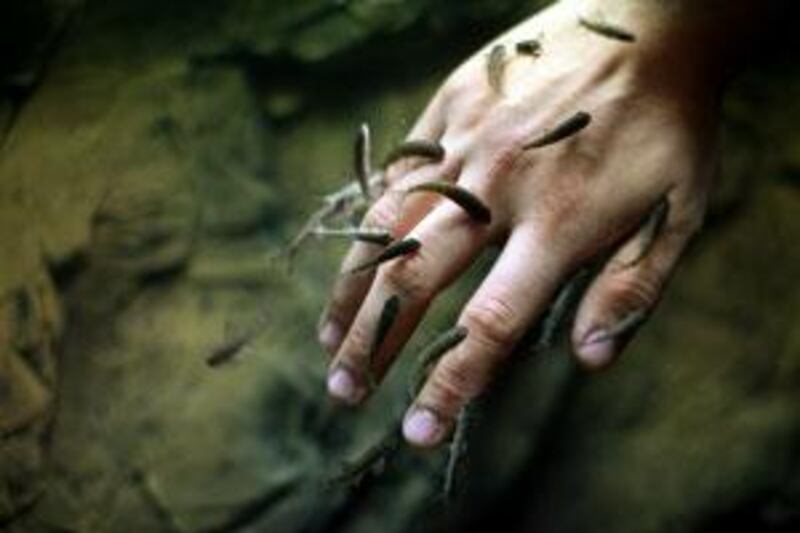How do you fancy having a fish nibble at you for your health? The latest trend in spa treatments arrived in Dubai this week, when the "doctor fish" went on display at the Aquariya Expo, an exhibition for the aquarium industry. The slender little fish, known to science as Garra rufa and originally found in the hot springs of Turkey, has traditionally been used to treat the skin disease psoriasis - it eats the dead cells but ignores healthy tissue. Latterly, however, it has found itself in demand all over the world at fashionable spas offering manicures and pedicures with a difference.
"It is an alternative therapy, something that is new for spas to pick up," said Kevin Tan, general manager of AquaArt, a Qatar-based company which is introducing the doctor fish to the Emirates. "There is a definite novelty factor; it is not about just getting manicures or pedicures done, but about doing them in a special way." The spas are designed around special fish-pools in which customers soak their hands and feet for approximately 15 minutes, allowing the fish to remove the dead surface skin, leaving the hands soft and clean, ready for the manicure.
"The fish soften the skin, so they do a much better job at scrubbing it down," said Mr Tan. He added that spas specialising in doctor fish had been active for a number of years across the world. "Although the fish originates from Turkey, the first people to market it in a therapeutic manner were the Japanese," he said. "Countries such as Japan, Germany, Malaysia, Singapore, and more recently the US, have opened up these spas. In some countries there are even fish-spa chains.
"For some reason, though, this region here has not caught on yet." The fish are considered national treasures in Turkey, and are a protected species, which means that they cannot be caught in the wild and then exported. At one point, however, some were taken out of Turkey for research purposes, which then led to mass-breeding. Now there are doctor fish farms all over the world, catering for the ever-increasing demand for alternative therapy, and are usually sold in lots of 1,000.
Also found at the expo for the first time was the "betta fish", also known as Siamese fighting fish. These have to be kept apart in individual tanks to prevent them from attacking each other. At the expo, they were in row upon row of small tanks separated by sheets of paper to keep them from seeing their neighbours - or even their own reflections. "When they spot another fish, they flare their fins, displaying their beautiful colours," said Edwin Lim, vice-president of the Betta Club, Singapore. Mr Lim, and hundreds of others, collect betta fish and breed them as a hobby, showing off their bright colours to other collectors. "We don't spar them any more, rather, we just display them."
Also at the expo was the nishikigoi. This fish, of which there are 200 varieties, is found only in Japan, but there are collectors all over the world, and one specimen can fetch up to US$500,000 (Dh1.8 million), depending on its breeding. "This particular fish is like art," said Hiroshi Toyama, service manager for the International Nishikigoi Promotion Center. "For the breeder, it's about the shape of the body, the colour, the quality."
The nishikigoi, similar to the koi fish (they both belong to the carp family), can come in a variety of rich colours, such as black, red, orange, yellow and white. "They are like a painting," Mr Toyama said. According to local culture, one reason the fish are so highly regarded in Japan is that they are believed to bring good luck. "They symbolise promotion, success, power, and peace," said Mr Toyama. Furthermore, they were much sought after because of their longevity: they can live up to 80 years.
"Ornamental fish is a growing market in the UAE, especially in terms of personal collectors," said Naseef Ahmed, of Orange Fairs and Events, the organisers of the expo. "In 2008, $1.14m worth of ornamental fish imports came into the UAE." nsamaha@thenational.ae






